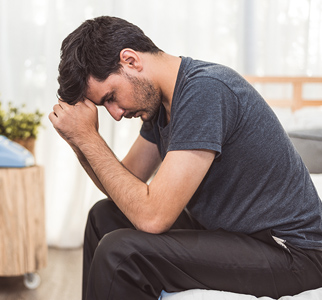December 2019
Know the Signs of Depression and Anxiety
Some days you just don’t feel your best. But for some people, those days turn into weeks or months. You might feel down all the time or worry constantly. Or you might notice you’re irritable nearly every day.

If this sounds familiar, you might have mental health condition such as depression or anxiety. Don’t worry—these conditions can be treated!
Talk with your healthcare provider if you think you may have one of these common mental health concerns.
Depression: More than just the blues
Feeling sad from time to time is a part of life. But for people with depression, these feelings interfere with daily living. Work, friendships, and self-care may suffer.
Sadness is one symptom of depression, but there are many others. Talk with your provider if you have any of these signs for at least 2 weeks:
-
You don’t enjoy the things and activities that you used to like, or they’re not as fun as they used to be
-
You feel empty, worthless, or helpless
-
You have trouble concentrating or making decisions
-
You’re fatigued, even after sleeping well
-
You’re thinking of hurting yourself
Even people with severe depression can recover. Treatment may involve medicine, counseling, or a combination of both.
Anxiety disorders: When worrying goes overboard
Do you feel like you’re always worrying? Or that you worry even though everything is fine? If so, you may have an anxiety disorder.
Occasional anxiety is normal. But sometimes anxiety won’t go away. This can interfere with your daily life.
There are several types of anxiety disorders. Common ones include:
-
Generalized anxiety disorder (GAD). People with GAD worry too much. They also may have physical symptoms such as sweating or trouble sleeping.
-
Panic disorder. Panic attacks are sudden bouts of extreme fear. These are the key symptom of panic disorder.
-
Social anxiety disorder. People with social anxiety have a strong fear of embarrassment or judgment in social settings.
If you’re struggling with anxiety, make an appointment to see your healthcare provider. He or she can make sure there’s no physical problem causing your symptoms and help you find an effective treatment.
Bipolar disorder: Extreme moods
Bipolar disorder is also called manic-depressive illness. People with bipolar disorder have unusual mood changes and intense emotions. During a manic episode, they feel very “up” and have a lot of energy. But during a depressive episode, they have bouts of sadness or feel hopeless.
Talk with your healthcare provider if you think you might have a mental health condition. Mental health conditions are treatable. Your provider may suggest medicine or counseling. Many people benefit from both.
Seasonal sadness: More than a phase
Do you start to feel depressed around November or December every year? You may suffer from seasonal affective disorder (SAD).
SAD is a type of depression. People with SAD have depression that comes and goes with the seasons. It usually starts in the late fall and early winter.
Talk with your healthcare provider if you feel depressed in the winter months. Light therapy and vitamin D can help you feel better. Medicine and counseling are also options.
If you take depression medicine, don’t skip doses. Medicine works best when you take it as prescribed.